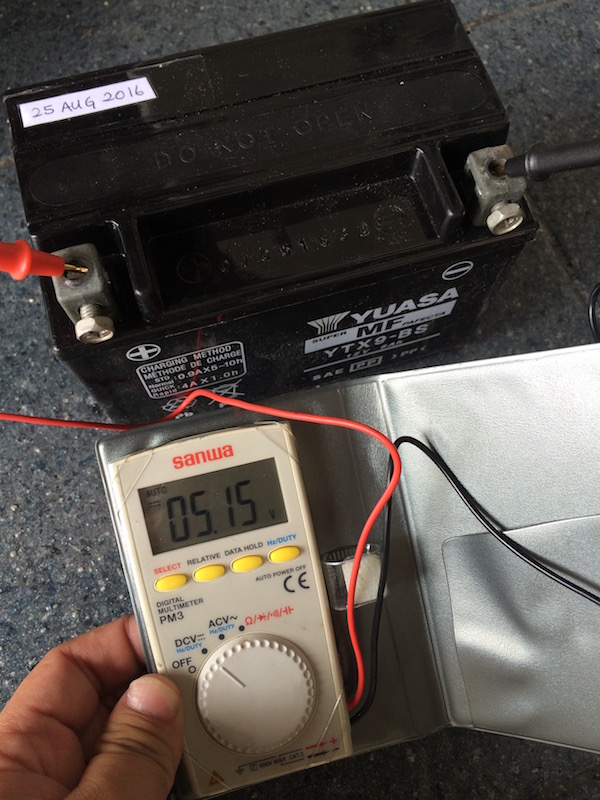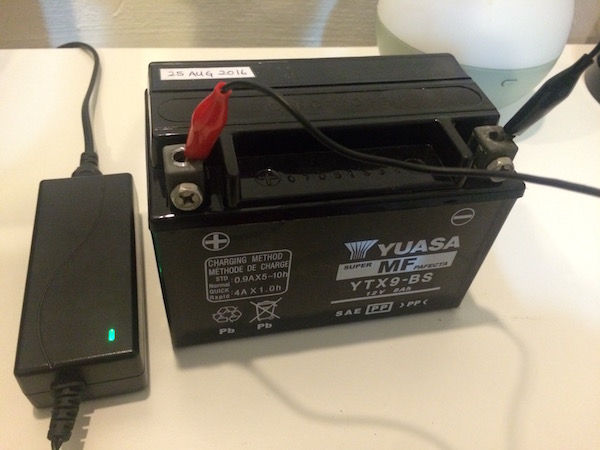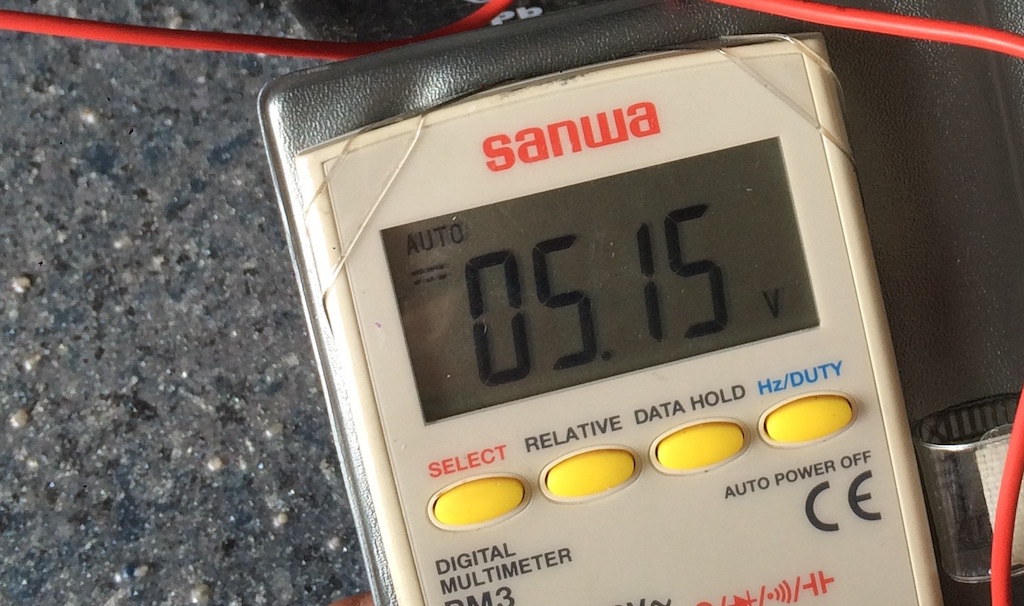Arghh! I couldn’t start my motorcycle again this morning! The last time I fired up my Pulsar 200NS was Tuesday – that’s only 5 days ago. Granted, I haven’t been riding much. But still, it was ONLY FIVE DAYS!
Since the last battery death and replacement, I’ve double checked all my additional electrical components, and am ABSOLUTE CERTAIN that, apart from the IU, none of the other additional electrical circuits are powered up when the bike is turned off. I’ve even went so far to remove my remote controlled alarm – which I suspected could be the cause of the battery drain.

So lo and behold, after 5 days of sitting idle, the Pulsar 200NS battery was completely drained. Again.
This time, determined to isolate the source of the battery drain, I switched the IU power wiring to receive power only when the bike is fired up. I’ll have to monitor it for the next round of sitting idle over a few days to see if the battery will hold. I didn’t measure the current draw of the IU, but after the switch, the bike is now consuming something like 0.2mA (that’s 200μA) when turned off – probably to power the internal clock. As an additional precaution, I also reseated the CDI’s electrical connection – just in case some loose connection there is inadvertently causing the power drain.
I’m praying it now resolves the battery drain issue. Otherwise, there could be something a lot more major. And I’m afraid to even think about it. =(

Meanwhile, I’ll juice up the Yuasa and see if it holds.


Rewiring the IU to the fusebox so that it is powered only when the bike is turned on was one of the first things I did to my bike.
But even when the IU was connected directly to the battery, the battery (YTZ10S) would still last about 2 weeks before it became too weak to start the bike. 5 days seem a bit short, unless your IU was drawing abnormally huge amounts of power. Or there is something else that is wrong.
I honestly am not sure. I’m really hoping it’s the IU, and that the rewiring solves the issue.
I’m facing that problem too. I’m quite sure the IU is the culprit. It only takes about 4 days to drain my battery from 13.0V to sub 12.0V. Hence, I got myself the Oxford Oximizer to maintain a +12.5V as I ride my Pulsar once every 2-3 days.
How does the Oxford Oximizer work?
Two ways… the cumbersome way is to remove the battery and keep it charged. The charger is smart enough to switch to trickle charging once it reaches around 13.0V.
My way is to charge it while leaving the battery in the bike by using a portable charger (3-pin plug) to power the Oxford (http://www.thestudiooutfitters.com/store2/shop/lightingsystems/invertersystems/en-350-mini-enegon-inverter/).
I must admit that this is not a safe method… but what the hey…
Huh? Such a setup is too messy and costly for me. My current setup is just an extra battery laying stashed somewhere and an old 4A 12Vdc switching regulator power supply I repurposed from a discarded electronic device to charge the Pb battery. Of course, I clipped off the DC jack on the power supply and added crocodile clips to it instead. You can see the pic of me using it above in this blog.
Cost of the makeshift charger? A mere $0.30 x 2 for the black and red croc clips. Purchased at Sim Lim Tower. =)
Of course your way is cheaper but I simply don’t use the pulsar often enough so battery drain will be always be an issue. Removing the bike battery, bring it up to my home, charge it, bring back to the bike and install… too much work. Then again, if I didn’t have my portable battery lying around at home, I probably use your method too.
How are you liking your Tricity so far? 🙂
Actually, I have a suggestion – simply remove the negative terminal if you don’t use it. I have a battery that stayed that way for 3 months and was still good enough to start the bike.
Tricity has been nice and it’s my go-to bike for wet weather, especially this month which rained a lot. While I still need to be careful, I don’t have to be overly cautious or stressed out when riding in the rain. In fact, I can still ride in heavy rain while others had to seek shelter and wait out. Being a 125cc, got no power lah… so just suck thumb and ride… oh, best feature of this bike is being able to put bigger items at the foot rest area which is flat. Too bad is not wide enough to put my foldable bike on it.
Yeah – I imagine that it would be great if you could mod it to include a rack for transporting your folding bike. 🙂
BTW, what happened to your blog? I don’t seem to find it…. =(
Hi Derrick, I’ve been having battery problems as well, and at just 3 weeks old I had a flat battery. I’m gonna try to follow what you did, but please enlighten this amateur as to where the Cdi is located. I’ve disconnected the IU so it definitely isn’t the cause of battery drain. Also, I have a automotive relay to connect my USB and camera, and I noticed the relay is hot, even when the bike is completely turned off. Is this normal? Or could that be a cause of battery drain. Appreciate any advice
1) In my case, the IU was definitely the culprit. My battery could previously barely last 3 or 4 days without firing up the engine. But with the wiring swap, I’ve recently NOT ridden by bike for close to 4 weeks now, and my battery is still good (just checked 2 days ago).
2) A warm relay is not a good sign – irregardless of whether your engine is turned on or not. Relays are pretty efficient and should consume only mA’s of current for the actuation. Once actuated, it’s a mechanical switch, and should theoretically consume no additional power on the circuit that it’s “turned on” (be it lights, IU, camera, USB, etc.) Do check and troubleshoot your wiring. A *hot* relay even when the bike is powered off is a huge telltale sign of some wrong wiring somewhere.
3) I’m assuming that you’re riding the 200NS? If so, the CDI is that little boxy thing underneath the pillion seat. Mine’s a little red, but held by a black plastic / rubber bracket. At the end towards the rider’s seat, you should find the connector of the CDI. Why do you need to access the CDI?
Oh crap, I guess it’s really my wiring. But this is the first time my battery went flat (my negative terminal was not connected properly the first time) and my relay has always been hot to touch. I’m also pretty sure everything is hooked up properly. Maybe I should try changing the relay? I want to make sure that the connection for the Cdi is secure, was just ruling out all the possibilities.
Well, it IS possible that you have a rogue relay…
Alright thanks a lot anyway! Will try a new relay as the first step.
Yes, the IU does draw current, event at rest. It is recommended to power the IU via the fusebox, where power is supplied thru the ignition ACC position.
It’s a multi-million LTA contract hindsight.
Good luck.
Hi that’s a great post, is the re-wiring of the IU something easy to do? My IU is active all the time even when the engine is off, I put in my cashcard and it reads the value even when engine is off.
Well, how “easy” it is depends on how familiar you are with the bike, and how confident you are with electrical wiring, yah? I’m sure almost any competent workshop mechanic will find it relatively easy. =) What do you ride BTW?
I’m riding a KTM duke 200. I’m quite ok with basic electrical wiring but nothing too complex, I’m comfortable with replacing the bike battery on my own… guess if it’s too difficult to re-wire the IU I’ll ask the workshop to re-wire for me
Ah! The Duke 200 – close cousin of the Pulsar 200NS! Check out my blog on “wiring up for power”. I have a separate relay that powers additional accessories. Fused and isolated – in case something goes wrong, it won’t affect the bike’s main electrical system. I attached the IU to this isolated system, which includes other accessories such as DVR, USB power, LED fogs, alarm…
http://sgbikerboy.com/2016/03/13/wiring-up-for-power-on-the-pulsar-200ns/
While how I configured it is not the only way to go about wiring up, I’d like to think it’s a “best practices” method to isolate any electrical add-on’s from the bike’s main electrical system. If you get a workshop to do it, they’ll likely just try to find an “ignition on” 12V source and hook up your IU there.